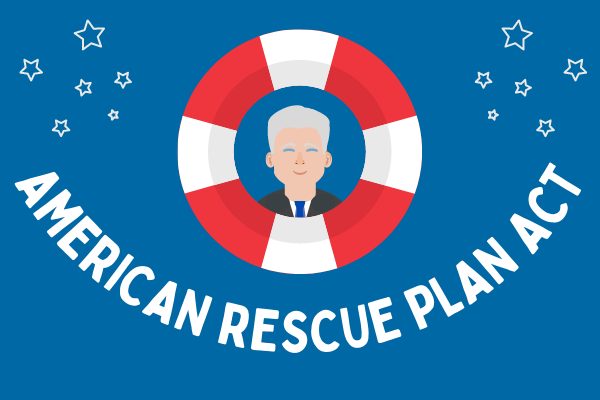The American Rescue Plan Act of 2021’s impact on payroll
 On Thursday, 3/11 President Biden signed the American Rescue Plan Act of 2021 (H.R. 1319 / ARP 21) into law. It was passed by Senate and sent back to the House who approved the Senate’s modified version. For most people, the centerpiece of this legislation is $1,400 checks to taxpayers whose 2020 adjusted gross income is less than $75,000 (single taxpayers) or $150,000 (marrieds filing jointly).
On Thursday, 3/11 President Biden signed the American Rescue Plan Act of 2021 (H.R. 1319 / ARP 21) into law. It was passed by Senate and sent back to the House who approved the Senate’s modified version. For most people, the centerpiece of this legislation is $1,400 checks to taxpayers whose 2020 adjusted gross income is less than $75,000 (single taxpayers) or $150,000 (marrieds filing jointly).
A word of warning: $1,400 checks are nice. But nice means phishers and scammers are already gearing up to separate recipients from their money. The Treasury Inspector General for Tax Administration has a flyer you may want to hand out to employees.
However, while these direct payments may have garnered the most attention, this sweeping piece of legislation also includes other significant provisions. that could impact employers, especially as it relates to payroll and leave.
The core payroll-related provisions include:
- An extension, expansion, and reordering of the paid sick/family payroll tax credits.
- An extension, expansion, and reordering of the employee retention credit.
- A requirement for employers to subsidize COBRA and a payroll tax credit for doing so.
- A temporary expansion of the tax-free amount employees can contribute to dependent care assistance programs.
Missing from the Senate’s bill is a freeze on inflation adjustments for 401(k) plans and the provision to raise the minimum wage to $15 an hour by 2025.
Tax credits for paid sick/family leave
The payroll tax credits for paid sick/family leave are extended through Sept. 30. Beginning with the second calendar quarter, the number of days against which tax credit can be taken is reset to 10 days. ARP 21 also adds a seventh category of qualified sick leave: leave associated with getting a COVID shot.
The payroll credit flips to the employer’s 1.45% share of Medicare taxes. While this may seem less generous than last year’s credit, theoretically it isn’t, since there’s no wage base for Medicare taxes.
You can’t discriminate in favor of highly compensated employees, full-time employees, or employees who have a long tenure.
State and local government employers are now eligible for the credit.
The payroll tax credit for providing paid family leave is extended through Sept. 30, but the weeks against which the credit may be taken have not been extended. Employees are only entitled to the paid leave they didn’t take last year.
The following changes have been made to this credit:
- Employees may take paid leave for any of the seven reasons they could take paid sick leave.
- The maximum amount of wages against which the credit may be taken increases to $12,000, from $10,000.
- The credit flips to a credit against the employer’s 1.45% share of Medicare taxes.
Employee retention credit
The employee retention credit, as modified by the Consolidated Appropriations Act is extended through the end of this year. Beginning July 1, 2021, it also flips to the employer’s 1.45% share Medicare taxes.
Severely financially distressed employers can credit wages paid to all employees during a calendar quarter. A severely financially distressed employer is defined as an employer whose gross receipts in 2021 are less than 10% of gross receipts for the same calendar quarter of 2019.
The credit for recovery startup businesses — businesses commencing after Feb. 15, 2020, with annual gross receipts not exceeding $1 million during the three taxable year period ending with the taxable year preceding the quarter — is increased to $50,000 per quarter, per employee.
COBRA subsidies
Normally, employees’ COBRA monthly premiums are 102% of the group rate. But that’s often a steep price for employees to pay.
Beginning April 1 through Sept. 30, ARP 21 sets the employee premium at $0. Employees qualify for this 100% subsidy if they terminated or had their work hours reduced. Employees remain eligible for the subsidy until the earliest of:
- The date they enroll in other group coverage or Medicare.
- The date they max out on COBRA coverage.
- Sept. 30.
Employees who could have elected COBRA coverage but didn’t, or employees who let their COBRA coverage lapse, have a 60-day special enrollment period, beginning April 1.
You must reimburse employees who pay the full COBRA premium after April 1. Your reimbursement is creditable, too.
Employees who quit aren’t eligible for the subsidy.
In addition to current COBRA notices, you must provide a supplemental notice regarding the special enrollment period and subsidy. The Department of Labor will create a model notice. Employees who have already elected COBRA must also receive notice.
You are entitled to a payroll tax credit against your share of 1.45% of Medicare taxes equal to the COBRA subsidy. As with all the other pandemic-related payroll tax credits, this credit is refundable and advanceable. You can also reduce your payroll deposits to pay for it, provided you reconcile your reduced deposits on your Form 941.
To prevent double-dipping, the company’s gross income is increased by the amount of the tax credit. In addition, the COBRA subsidy can’t be taken into account for purposes of group health plan expenses allocable to the employee retention credit or the paid sick/family leave credits.
Dependent care assistance
For 2021, the $5,000 maximum amount increases to $10,500. Plans must be amended to account for this temporary increase, but retroactive amendments are allowed.
Additional Resource: More questions on payroll? See answers to some recent reader questions.




